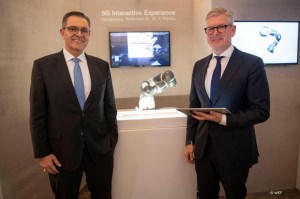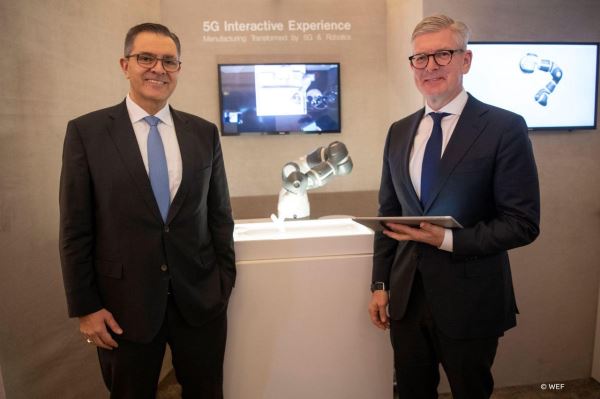ABB, Ericsson and Swisscom showed visitors at the recent World Economic Forum 2020 in Davos, Switzerland, how the real-time communication capabilities of 5G can effectively control robots over long distances.
ABB demonstrated a YuMi collaborative robot could carving a message in a sandbox that was replicated at the same time by a second YuMi 1.5 km away.
This action was possible thanks to Swisscom’s 5G network equipped with Ericsson technology in real-time and was viewed on video screens at both locations.
“5G wireless technologies make it easier to connect robots to the cloud and factory automation systems, enabling faster access to more data and better decision-making based on insights which will help improve efficiency and reliability through the entire production cycle,” said President of ABB’s Robotics and Discrete Automation business, Sami Atiya.
“As we replace traditional wire set-ups with 5G mobile networks, we can significantly increase flexibility in manufacturing.”
Swisscom Chief Executive, Urs Schaeppi said: "The joint demo uses our live 5G network in Davos to give a glimpse of the capabilities and various possibilities of 5G for manufacturing and robotics. The time is now to step into 5G.”
This technology paves the way for the highest flexibility for machines on the factory floor. Utilising 5G networks, the deployment and operations of large fleets of autonomous machines and robots will become a reality.
A significant benefit from 5G in industrial environments is that instead of a single control/single purpose operating approach, multi-machines can be controlled by one central resource, reducing the cost of managing and maintaining OT as well as IT systems, on a global basis.
Collaboration and partnerships
ABB and Ericsson’s multi-year technical collaboration has enabled the development of the fundamental technologies needed to connect machines via a 5G mobile.
“5G technology partnerships across business, government and society are key to developing the digital economy. By embracing and enabling such partnerships, new digital opportunities can be realized to benefit the global economy, national economies, and businesses of all sizes,” said Börje Ekholm, President and CEO, Ericsson.
ABB Chief Executive and Chairman, Peter Voser, added: “ABB will continue to drive the digital transformation of industries by investing in developing innovative solutions and products. Our partnership with Ericsson and Swisscom helps us to seize the full potential of 5G for industrial manufacturing.”
5G technology in Australia
5G is already available in Australia, in selected areas of major cities. More widespread deployment of this technology is expected in 2020.
5G will enable robots to be controlled wirelessly rather than through wired communication links, meaning they will not need to take up data storage resources on the cloud and can be controlled in real-time.
The technology is still in its infancy, but quickly catching up. Telstra has bought 5G coverage to 25 cities across Australia as part of its $3.8 billion investment in its mobile network over the three years to June 2020.
It aims to be the global leader in the roll of out of 5G coverage and is the first company to offer 5G to Australians. Telstra recognises the widespread benefits 5G will have for industries, including agriculture, logistics and manufacturing.
In December 2019, Telstra announced the switch on of 5G coverage in Dubbo, NSW.
“Dubbo sits at the centre of a road network that connects our major metro cities. It is built on industries – transport, logistics, agriculture, manufacturing – that will all benefit greatly from our 5G rollout,” said Telstra Chief Executive, Andrew Penn.
“In transport and logistics, 5G will mean systems that can be managed and synchronised to the real-time movement of vehicles and passengers, he said.
“In agriculture, 5G will mean sensors that can gather geographically-precise data in real-time to better monitor livestock and crops based on exact and local weather patterns, soil moisture and nutrients.
“In manufacturing, 5G and artificial intelligence will mean automation and robotics to perform repetitive tasks and drive new efficiencies and productivity.
“And elsewhere, 5G will mean drones that could be used for deliveries, searches, rescues or to provide high quality live video for news or surveillance.”


